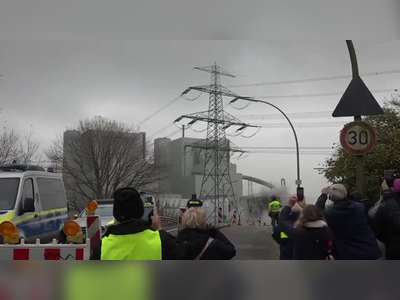
Breakthrough Scan Reveals Titanic's Final Moments
Advanced 3D mapping sheds light on the historic ship's sinking and the efforts of its crew.
A comprehensive new scan of the Titanic has unveiled crucial details about the ship's final moments before its sinking in 1912. Utilizing advanced technology, researchers created an exact 3D replica of the wreck, highlighting the catastrophic events as the vessel succumbed to the North Atlantic after colliding with an iceberg.
The findings substantiate historical eye-witness accounts, particularly noting the efforts of engineers who tirelessly worked in the boiler room to maintain power and light for the duration of the disaster.
The scanning project revealed that the Titanic suffered punctures in the hull, roughly the size of an A4 sheet of paper, leading to its eventual sinking.
The ship, which went down on April 15, 1912, was carrying approximately 2,224 passengers and crew, with around 1,500 lives lost in the tragedy.
Mapping the wreck, which rests approximately 3,800 meters on the ocean floor, involved underwater robots capturing over 700,000 images to produce the detailed 3D representation.
This visualization shows the bow and stern of the ship separated by 600 meters, confirming the split that occurred as it hit the ocean floor.
Park Stephenson, a Titanic analyst, emphasized the historical significance of the wreck, considering it the last surviving eyewitness to the disaster.
He stated that understanding the context of the wreck site is vital for grasping what transpired during the disaster.
The scan further revealed broken portholes, which may have been damaged by the iceberg, supporting individual accounts of ice entering cabin areas.
According to the analysis, the ship's lights remained operational as it sank, corroborated by the concave appearance of the boiler rooms where engineers were found.
Notably, Joseph Bell, an engineer, led his team in shoveling coal to sustain the ship's power system, allowing for a semblance of order as lifeboats were prepared for evacuation.
Advanced computational modeling techniques were employed to recreate the circumstances surrounding the sinking, including the ship's speed, trajectory, and the extent of damage.
Research indicates that the Titanic sustained a scrape against the iceberg, resulting in punctures across six compartments of the hull.
Simon Benson, an associate lecturer in naval architecture, noted the criticality of these small breaches, stating that the difference between the Titanic surviving and sinking rested on narrow openings that gradually allowed water to flood the compartments.
The imagery captured from the wreck site also depicts personal belongings scattered across the sea floor, leading researchers to anticipate that it will take years to fully unravel the details regarding the events of that fateful night in 1912. The findings were revealed as part of a documentary produced by National Geographic and Atlantic Productions, further contributing to ongoing research into one of maritime history's most notorious tragedies.
The findings substantiate historical eye-witness accounts, particularly noting the efforts of engineers who tirelessly worked in the boiler room to maintain power and light for the duration of the disaster.
The scanning project revealed that the Titanic suffered punctures in the hull, roughly the size of an A4 sheet of paper, leading to its eventual sinking.
The ship, which went down on April 15, 1912, was carrying approximately 2,224 passengers and crew, with around 1,500 lives lost in the tragedy.
Mapping the wreck, which rests approximately 3,800 meters on the ocean floor, involved underwater robots capturing over 700,000 images to produce the detailed 3D representation.
This visualization shows the bow and stern of the ship separated by 600 meters, confirming the split that occurred as it hit the ocean floor.
Park Stephenson, a Titanic analyst, emphasized the historical significance of the wreck, considering it the last surviving eyewitness to the disaster.
He stated that understanding the context of the wreck site is vital for grasping what transpired during the disaster.
The scan further revealed broken portholes, which may have been damaged by the iceberg, supporting individual accounts of ice entering cabin areas.
According to the analysis, the ship's lights remained operational as it sank, corroborated by the concave appearance of the boiler rooms where engineers were found.
Notably, Joseph Bell, an engineer, led his team in shoveling coal to sustain the ship's power system, allowing for a semblance of order as lifeboats were prepared for evacuation.
Advanced computational modeling techniques were employed to recreate the circumstances surrounding the sinking, including the ship's speed, trajectory, and the extent of damage.
Research indicates that the Titanic sustained a scrape against the iceberg, resulting in punctures across six compartments of the hull.
Simon Benson, an associate lecturer in naval architecture, noted the criticality of these small breaches, stating that the difference between the Titanic surviving and sinking rested on narrow openings that gradually allowed water to flood the compartments.
The imagery captured from the wreck site also depicts personal belongings scattered across the sea floor, leading researchers to anticipate that it will take years to fully unravel the details regarding the events of that fateful night in 1912. The findings were revealed as part of a documentary produced by National Geographic and Atlantic Productions, further contributing to ongoing research into one of maritime history's most notorious tragedies.










